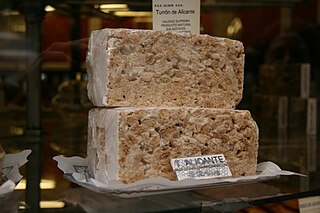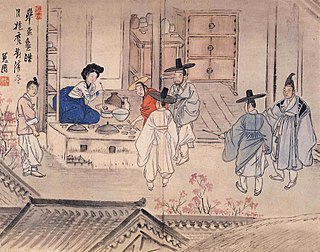
Fortified wine is a wine to which a distilled spirit, usually brandy, has been added. In the course of some centuries, winemakers have developed many different styles of fortified wine, including port, sherry, madeira, Marsala, Commandaria wine, and the aromatised wine vermouth.

Tequila is a distilled beverage made from the blue agave plant, primarily in the area surrounding the city of Tequila 65 km (40 mi) northwest of Guadalajara, and in the Jaliscan Highlands of the central western Mexican state of Jalisco.
Schnapps or schnaps is a type of alcoholic beverage that may take several forms, including distilled fruit brandies, herbal liqueurs, infusions, and "flavored liqueurs" made by adding fruit syrups, spices, or artificial flavorings to neutral grain spirits.

Anisette, or Anis, is an anise-flavored liqueur that is consumed in most Mediterranean countries. It is colorless and, because it contains sugar, is sweeter than dry anise flavoured spirits. The most traditional style of anisette is that produced by means of distilling aniseed, and is differentiated from those produced by simple maceration by the inclusion of the word distilled on the label.

A bitters is traditionally an alcoholic preparation flavored with botanical matter for a bitter or bittersweet flavor. Originally, numerous longstanding brands of bitters were developed as patent medicines, but now are sold as digestifs, sometimes with herbal properties, and as cocktail flavorings.

Turrón, torró or torrone is a Mediterranean nougat confection, typically made of honey, sugar, and egg white, with toasted almonds or other nuts, and usually shaped either into a rectangular tablet or a round cake. Turrón is usually eaten as a dessert food around Christmas in Spain and Italy. In Malta it is sold in street stalls as qubbajd during the parish patron saint feast of the various localities.

Grenache or Garnacha is one of the most widely planted red wine grape varieties in the world. It ripens late, so it needs hot, dry conditions such as those found in Spain, where the grape is believed to have originated. It is also grown in the Italian island of Sardinia, the south of France, Australia, and California's Monterey AVA, Paso Robles, Santa Barbara County and San Joaquin Valley.
Apéritifs and digestifs are drinks, typically alcoholic, that are normally served respectively before and after a meal.

Crème de Noyaux is an almond-flavored crème liqueur, although it is actually made from apricot kernels or the kernels of peach or cherry pits, which provide an almond-like flavor. Both Bols and Hiram Walker produce artificially colored red versions of the liqueur while Noyau de Poissy from France is available in both clear (blanc) and barrel-aged amber (ambre) versions.

Aguardente (Portuguese) or aguardiente (Spanish) is a type of distilled alcoholic spirit that contains between 29% and 60% alcohol by volume (ABV). It is a somewhat generic term that can refer to liquors made from various foods. It originates from and is typically consumed on the Iberian Peninsula and in Iberian America.

Baijiu, or shaojiu, is a colorless Chinese liquor typically coming in between 35% and 60% alcohol by volume (ABV). Each type of baijiu uses its own type of qū for fermentation to create a distinct and characteristic flavor profile.

Liquor or distilled beverages are alcoholic drinks produced by the distillation of grains, fruits, vegetables, or sugar that have already gone through alcoholic fermentation. Other terms for liquor include spirit, spirituous liquor or hard liquor. While the word liquor ordinarily refers to distilled alcoholic spirits rather than beverages produced by fermentation alone, it can sometimes be used more broadly to refer to any alcoholic beverage.

Korean cuisine has a wide variety of traditional alcoholic drinks, known as sul (술). Many of these drinks end with the Sino-Korean word -ju, and some end with the native Korean word -sul. The Sino-Korean -ju is not used as an independent noun.
Herbero is a liquor made in the Sierra de Mariola region in the northern part of the Spanish province of Alicante. This mountain range is famous for its abundance of medicinal and aromatic plants, some of which are used to make the herbero liquor. Herbero is often found in a regional cocktail called mesclaet.

A flaming drink is a cocktail or other mixed drink that contains flammable, high-proof alcohol, which is ignited before consumption. The alcohol may be an integral part of the drink, or it may be floated as a thin layer across the top of the drink. The flames are mostly for dramatic flair. However, in combination with certain ingredients, the flavor of the drink is altered. Some flavors are enhanced, and the process may impart a toasted flavor to some drinks.
Lambanóg is a traditional Filipino distilled palm liquor. It is an alcoholic liquor made from the distillation of naturally fermented sap (tubâ) from palm trees such as sugar palm, coconut, or nipa. Lambanog is well-known for having a strong alcohol concentration and can be used as a base liquor for various flavored spirits and cocktail creations. The most popular variety is the coconut lambanog which is commonly described as "coconut vodka" due to its clear to milky white color and high alcohol content. It originates from Luzon and the Visayas Islands. During the Spanish colonial period, it was also known as vino de coco in Spanish. It is particularly potent, having a typical alcohol content of 80 to 90 proof after a single distillation; this may go as high as 166 proof after the second distillation.

Drinks containing alcohol are typically divided into three classes—beers, wines, and spirits—with alcohol content typically between 3% and 50%. Drinks with less than 0.5% are sometimes considered non-alcoholic.

Hierbas de Mallorca or Herbs de Majorca is a Mallorcan herbal liqueur of medicinal origin. A form of the generic Hierbas, Hierbas de Mallorca has a protected designation of origin and can only be made in Mallorca.

Huangjiu is a type of Chinese rice wine (mijiu) most popular in the Jiangnan area. Huangjiu is brewed by mixing steamed grains including rice, glutinous rice or millet with qū as starter culture, followed by saccharification and fermentation at around 13–18 °C (55–64 °F) for fortnights. Its alcohol content is typically 8% to 20%.
Laksoy, is a traditional Filipino distilled nipa palm liquor. It is derived from tubâ made from nipa palm sap that has been aged for at least 48 hours. It originates from Eastern Mindanao, the Visayas Islands,, the Bicol Region, and Southern Luzon. During the Spanish colonial period, it was also known as vino de nipa in Spanish. It has a typical alcohol content of 70 to 100 proof after a single distillation.














